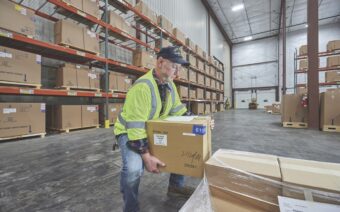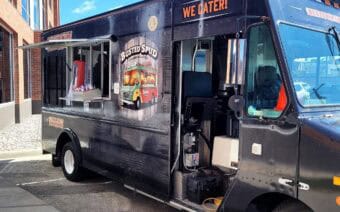
February 9, 2023
APPLETON — A few years ago, a group of Hmong community members got together to brainstorm about how to improve the lives of Hmong Americans living and working in Northeast Wisconsin.
Though they or their families had been in Wisconsin for four decades, they sometimes felt like they had just arrived.
Like many immigrants, they wanted a good life for themselves and their families.
According to the 2021 American Community Survey, Wisconsin is No. 3 in population of Hmong individuals – below California and Minnesota, No. 1 and 2, respectively – with an estimated 62,000 Hmong living in the Badger state.
In addition, the Pew Research Foundation said 66% of Hmong in the United States were born in the U.S.
Through much brainstorming, the concept for NEW Hmong Professionals was born – a nonprofit aimed at connecting and showcasing individuals of Hmong heritage throughout Northeast Wisconsin.
“Its commitment is to create safe spaces that engage, empower and elevate Hmong professionals in Northeast Wisconsin,” Long Vue, executive director of the non-profit based in Appleton, said.
Vue said the group hopes to achieve that through networking, serving as mentors to others and being positive representatives of the Hmong community, while retaining their identity as Hmong Americans.
He said the members of the nonprofit realized by working together, it could move through challenges more efficiently and find comfort in supporting one another.
“We serve as a trusted organization for Hmong Professionals in Northeast Wisconsin that cultivates and sustains productive, engaged and resilient leaders who have a strong sense of identity and belonging in our communities,” Vue said.
Manimatana Lee, community coordinator with NEW Hmong Professionals, said being a minority in a community is challenging.
“We live in two worlds struggling to fit in with our culture and everyone else around us,” she said. “As one of our goals, we want to make sure they belong wherever they go, especially in this diverse community.”
Family first
Vue, his parents and his siblings came to Kaukauna in 1980 – five years after the Vietnam War ended.
He said his family intended to settle in Appleton, where he had an uncle who would serve as their sponsor.
“However, (there was) not (an) available house for rent,” he said. “So, we ended up in Kaukauna.”
After college and working elsewhere for a few years, Vue said he returned to the area.

Long Vue
“Family is critical to the Hmong,” he said. “This is one of the reasons we have a large population of Hmong in Northeast Wisconsin in the first place.”
Sadly, Vue’s father passed away in 2003.
Not wanting to uproot his mother, Vue said he moved into the family house with her.
“My mom is comfortable living in this area,” he said. “This is only the area she is familiar with. We did not want to uproot her.”
Laying the groundwork
Vue said surveying peers helped NEW Hmong Professionals founders pinpoint five priority areas of need – identity formation, mental health, community engagement (networking/volunteering), entrepreneurship and personal and professional development.
“Our goal is to provide professional development to Hmong professionals based on these areas of need,” he said. “It means developing programs to meet these needs of NEW Hmong Professionals while fulfilling the emerging needs of the Hmong community.”
NEW Hmong Professionals originally started as a volunteer-led effort, but Vue said eventually, the group realized the needs of the Hmong community were greater than a group of volunteers could address.
In January 2020, NEW Hmong Professionals incorporated as a 501(c)3 nonprofit organization.
Then, Vue said, the COVID-19 pandemic shut everything down.
But through the uncertainty, he said the group’s ideas incubated and plans grew, and keeping in touch remotely helped them band together.
Today, the group has a staff of five employees – an executive director, program coordinator, project coordinator, community outreach specialist and community health and wealth coordinator, as well as a board of directors.
Two years and many activities later, Vue said the organization recently celebrated the grand opening of its first brick-and-mortar center at 1444 E. Northland Ave.
In addition to a ribbon cutting, the event included a presentation, the Hmong Elders program and a performance by Hmong dancers.
Vue called the opening of the center an accumulation of many months of hard work and dedication.
“To truly meet the needs of the Hmong community and our professionals, we need a space to provide programs for elders and youth, house our hydroponics project and offer workshops and conferences,” he said.
The group will utilize the space to continue its various networking, career development and leadership opportunities.
Vue said the building will also be used for cultural events, learning to play the qeej (a musical instrument), hunters’ safety training and a roster of other programs.
Recently, the center was the setting for a sewing bee – an event where a dozen or so women of all ages got together to embroider paj ntaub, which is pronounced “pan dau” and means flower cloth.
Vue said they meet weekly, many of them making wraparound, sling-style baby carriers.
“We’re open to anyone who has the passion and desire to help the Hmong in our community,” he said.

Through the NEW Hmong Professionals group, Hmong elders have been able to garden and network with each other. Submitted Photo
In regard to the importance of creating diversity among professionals in Northeast Wisconsin, Vue reframed the question.
“The question is not about the importance of having (diversity)… in Northeast Wisconsin,” he said. “(The question should be), how are we going to retain diversity in Northeast Wisconsin.”
Vue said NEW Hmong Professionals strongly believes if the group is able to create that safe space for Hmong professionals to be engaged, empowered and elevated, “we will most likely (persuade) a diverse group of professionals, including the Hmong, to stay in Northeast Wisconsin.”
“They have family and relatives here, and they do not want to leave them behind,” he said. “If we don’t create this safe space for them, they will leave this area and find a new place to call home.”
A wide reach
It’s the range of offerings that Vue said makes NEW Hmong Professionals different from other networking groups – reaching beyond other professional groups’ typical entrepreneur or how-to-promote-your-business seminars.
“To meet the emerging needs of the Hmong community, we are currently (offering) several programs – including paj ntaub, hydroponics, youth volleyball and youth dancing,” Vue said.
Lee said the group aims to offer events/programs for every age group to participate in, “because we want them to stay active in the Hmong community.”
“Cross-stitching is our newest activity we started and it has been very successful,” she said. “We found interest from all ages, and recently opened it up to everyone.”
Lee said cross-stitching is a popular hobby Hmong elders have been doing since living back in Laos.
“This brings them a sense of comfort because they get to make specific items for their loved ones,” she said. “The youth and young adults are interested in learning this hobby so they can continue to pass it the younger generations.”
Another project, the Elders Story Project, Vue said, involves recording elders telling their stories and sharing their experiences.
Vue said the group is also planning several projects for Hmong Day and Asian Heritage Month in May.
More information on the nonprofit’s events/programs can be found on the group’s website at newhmongprofessionals.org.
 Fostering conversations around statewide childcare crisis
Fostering conversations around statewide childcare crisis Summery scents, sights at Suring’s Lavender Homestead
Summery scents, sights at Suring’s Lavender Homestead







